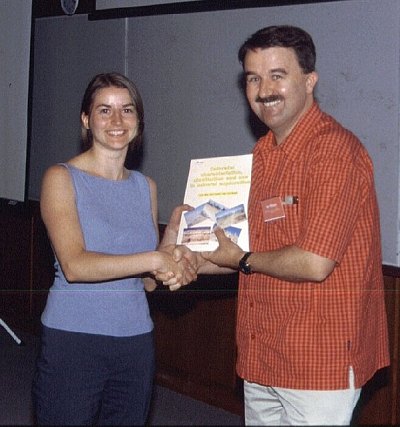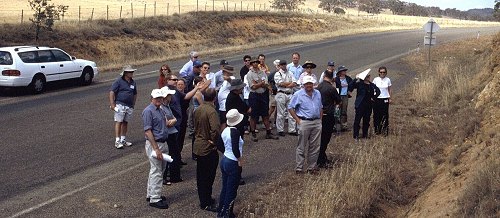2002 News Archive
First CRC LEME short regolith conference
Regolith and Landscapes in Eastern Australia
What do microbes have to do with regolith development and gold
exploration? How would you best sample vegetation for mineral exploration?
Where was the dust that recently blanketed Eastern Australia sourced
from? How long does it take termites to cycle quartz grains through
the soil?
The answers to these questions, and many more, can be found in
Regolith and Landscapes in Eastern Australia, the proceedings of
the First CRC LEME short regolith conference. The conference, sponsored
by CRC LEME and the Minerals Council of Australia, was held at the
University of Canberra over 21 and 22 November 2002. Seventy five
registrants consisted of CRC LEME research students and staff from
the Australian National University, Geoscience Australia, University
of Canberra and University of New South Wales plus researchers from
the ANU, CSIRO Land and Water, Geoscience Australia, Department
of Natural Resources and Energy, Victoria, NSW Department of Land
and Water Conservation, NSW Department of Minerals Resources, Macquarie
University, University of Melbourne and University of Adelaide.
The conference was designed to highlight the richness of research
currently being conducted under the CRC LEME banner in Eastern Australia,
as well as to allow other regolith researchers outside the organisation
to show off their own work. Also, the achievements of Professor
Tony Eggleton and Associate Professor Graham Taylor, two of LEME-1's
stalwarts, were celebrated by awarding the Taylor & Eggleton
book award to the best student presentation at the conference. Students
were the principal focus of the conference, which was well-attended
by undergraduate, Honours and postgraduates from throughout eastern
Australia.
Professor Roger Dean, Vice Chancellor of the University of Canberra,
and Dr Dennis Gee, CEO of CRC LEME, opened the conference and each
spoke of their ambitions to encourage innovation in research, the
former in science generally, and the latter in regolith science
focussed on the needs of its end-users. Keynote speaker Associate
Professor Graham Taylor stressed the need for the CRC backing innovation,
praising the Gilmore project and research in the Broken Hill area
by Steve Hill and team. Graham also called for empirical research
(which he called "stamp collecting") being backed up by
more fundamental research into processes. After all, many of the
regolith techniques currently used in mineral exploration are known
to work in certain regions, however, often we don't truly understand
why they work, there and perhaps not in other areas.
What then followed were a series of excellent, very professional
presentations and posters delivered primarily by CRC LEME research
students from the ANU and UC. A number of CRC staff and researchers
from other institutions (above) also contributed presentations and
posters, ensuring a packed program. Themes for the conference included:
Soils and Sediments; Water and Salt; Mineralogy, Microbiology and
Resource Management; Mapping and Landscape Evolution; and Minerals,
abbreviated by a mid-conference barbecue dinner on the lawns at
UC. Each of the presentations served to highlight the diversity
of research being conducted on regolith in Eastern Australia.
Keynote speaker Professor Tony Eggleton closed the conference by
delivering an insightful presentation on the past and future of
regolith research, which can be downloaded in PDF form here.
Three prizes for student excellence were awarded after the closing
address. It was very difficult to try and choose three presentations
from the throng of excellent work, however, congratulations go to:
- Taylor & Eggleton Book Award for overall excellence
Frank Reith (CRC LEME/ANU PhD scholar) "Interactions of microorganisms
with gold and regolith materials from a gold mine near Mogo in
southeastern New South Wales".
- Regolith Glossary Award for excellence in presentation
Angela Ratchford (CRC LEME/UC Honours scholar) "Regolith
influence on surficial water chemistry at Hovells Creek, central
west NSW: dryland salinity hazard mitigation in high-relief granitic
landscape" (with C. Leah Moore). Awarded in Angela's absence.
- Editor's Choice Award for excellence in written work
Leanne Hill (CRC LEME/ANU PhD scholar) " Branching out into
biogeochemical surveys: a guide to vegetation sampling" and
"A method of bulk sampling wet and dry atmospheric deposition
for trace element analysis" (with Patrice de Caritat).
As conference convener I was enormously excited by the breadth
and depth of research presented and the excellence of the written
abstracts, presentations and posters. Much of the research was of
direct benefit to the minerals exploration industry, however, other
disciplines including salinity mapping and management, agriculture,
acid sulphate soils mapping and management, regolith mapping, landscape
evolution, regolith geochemistry and biogeochemistry were also included.
The conference was a very potent tool for showing off the research
but also for allowing cross-fertilisation of ideas between the different
participants.
To close the highly successful conference, 40 delegates were treated
to an afternoon looking at some particularly Eastern Australian-flavoured
regolith at a parna site near Sutton, NSW, and overlooking Lake
George, NSW, lead by Graham Taylor. The party then retired to Madew's
Vineyard on the footslopes of the Lake George Fault to enjoy the
fruits of Pleistocene strandlines prominent on the Lake's northern
side.
Comments? Overall a highly successful conference, marred only by
a forgotten password to the university computer system (which was
quickly rediscovered). Delegates left happy, well fed, and enthused
to continue their research in their own particular disciplines but
also with a greater knowledge of the existing and possible synergies
between all the disciplines that make up regolith science.
Congratulations to all participants on a wonderful conference and
thanks to all the session chairs (Bear McPhail, Peter Lewis, Colin
Pain and Pat James). Personally, I am looking forward to participating
in next year's conference, to be held at the ANU towards the end
of November 2003. Keep an eye on the LEME WWW page!
Copies of the abstract volume (136 pp + CD-ROM) can be purchased
directly from CRC LEME via the WWW
site for A$44.00 including GST.
Dr Ian Roach
Conference convener and extended abstract volume editor.
Ian.Roach@anu.edu.au
Figures:

Figure 1: Taylor & Eggleton book award winner Frank Reith (ANU
PhD scholar) accepts his award from Graham Taylor (left) and Tony
Eggleton (right).

Figure 2: Editor's Choice book award winner Leanne Hill accepts
her prize from Dr Ian Roach, conference convener and abstract volume
editor.

Figure 3: An excitable (and exciting) crowd on the post-conference
field trip to the Sutton parna field site.

Figure 4: Enjoying the ambience (and talking about regolith) at
the end of the post-conference field trip at Madews Vineyard, Lake
George, are (L-R) Nerida Reilly (GA), Linda Bibby (NRE Vic), Michael
Holzapfel (CRC LEME/UC), Steve Hill (CRC LEME/UC) and John Rogers
(ANU).
|
